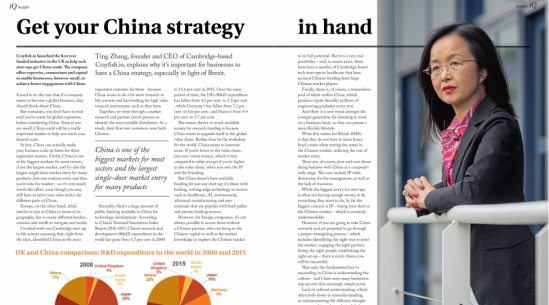Companies, whatever their size or sector, need to have a China strategy in place if they are going to take advantage of the many opportunities the Chinese market presents. That is the message highlighted by Crayfish Founder and CEO Ting Zhang in an article in Cambridge Independent this week., where she stresses the importance of such strategy, especially in the light of Brexit.
Ting Zhang is founder and CEO of Crayfish.io, the Cambridge-based start-up offering expertise, connections and capital to enable businesses to achieve better engagement with China. Last month, Crayfish.io launched the first ever funded initiative in the UK to help tech start-ups get China-ready. Here Ting explains why it’s important for businesses, however small, to have a China strategy – especially in light of Brexit which could make it more difficult for British companies to tackle Europe in the future.
Ting Zhang says:
It used to be the case that if a company wants to become a global business, they should think about China. But nowadays you don’t have to wait until you’re ready for global expansion before considering China. Even if you are small, China could still be a really important market to help you reach your desired scale.
In fact, China can actually make your business scale up faster for three important reasons:
Firstly, China is one of the biggest markets for most sectors, if not the largest market, and it’s also the largest single-door market entry for many products. Just one customs entry and then you’re into the market – so it’s very much worth the effort even though you may still have to tailor your sales tactics for different parts of China. Europe, on the other hand, while similar in size to China in terms of its geography, has so many different borders, customs and tariffs to navigate and tackle.
I worked with one Cambridge start-up in life science scanning that, right from the start, identified China as the most important customer for them – because China wants to do a lot more research in life sciences and has funding for high value research instruments such as they have. Together, we went through a market research and partner search process to identify the most suitable distributor. As a result, their first two customers were both Chinese.
Secondly, there’s a huge amount of public funding available in China for technology development. According to China’s National Innovation Index Report 2016-1017, China’s research and development (R&D) expenditure in the world has gone from 1.7% in 2000 to 15.6% in 2015. Over the same period of time, the UK’s R&D expenditure has fallen from 4.1% to 3.3% while Germany’s has fallen from 7.2% to 6.6%; and France’s from 4.4% to 3.7%.
The reason there’s so much available money for research funding is because China wants to upgrade itself in the global value chain. Rather than be the workshop for the world, China wants to innovate more. If you’re lower in the value chain, you earn ‘sweat money’ which is tiny compared to what you get if you’re higher in the value chain, when you own the IP and the branding.
However, China doesn’t have available funding for just any start-up; it’s those with leading, cutting-edge technology in sectors such as healthcare, AI, environment, advanced manufacturing and new materials that are popular with both public and private funding sources. However, for foreign companies, it’s not always possible to access these without a Chinese partner, who can bring in the Chinese capital as well as the market knowledge to explore the Chinese market to its full potential. But it is a very real possibility – and, in recent years, there have been a number of Cambridge-based tech start-ups in healthcare that have secured Chinese funding from large Chinese market players.
Finally, there is, of course, a tremendous pool of talent within China, which produces (quite literally) millions of engineering graduates every year. And there is a new trend amongst the younger generation for choosing to work on a freelance basis so that they can pursue a more flexible lifestyle. What this means for British SMEs is that they do not have to incur heavy headcounts when testing the water in the Chinese market, reducing the cost of market entry.
There are, of course, pros and cons about doing business with China at a company’s early stage. The cons include IP risks, distraction for the management as well as the lack of resources. Whilst the biggest worry for start-ups is often not having enough money to do everything they want to do, by far the biggest concern is IP – losing your shirt in the Chinese market – which is certainly understandable.
However, if you are going to take China seriously and are prepared to go through a proper strategizing process – which includes identifying the right way to enter the market, engaging the right partner, hiring the right people, establishing the right set up – there is every chance you will be successful.
That said, the fundamental key to succeeding in China is understanding the culture – and I have seen many businesses trip up over this seemingly simple point. Lack of cultural understanding, which often boils down to misunderstanding or misinterpreting the different thought processes, ultimately results in failed communications and a mismatch of expectations on both sides. This is most important to understand and get right, and is typically what goes wrong.
But, at the end of the day, China is a big market not to be ignored. So, if you succeed in China, you succeed big – no matter what size your business is.
Published by Iliffe Media on IQ magazine. Issue 30: September – November 2019.
